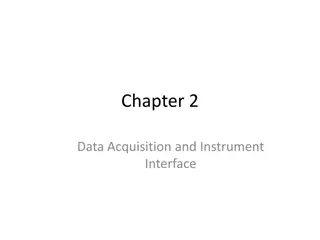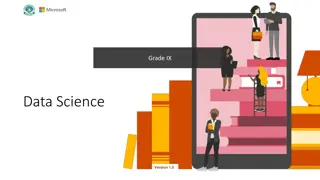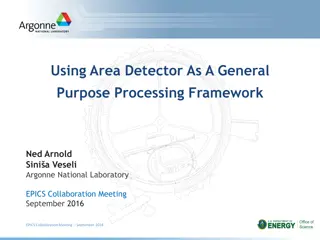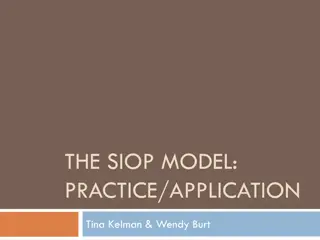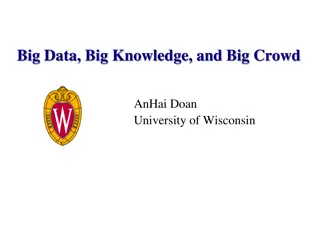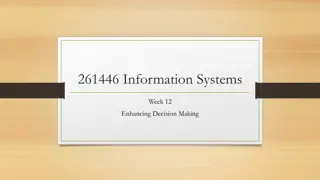Importance of Data in Decision Making and Knowledge Acquisition
Acquiring knowledge begins with gathering data, which forms the basis of important life decisions. This lecture emphasizes the significance of data collection and utilization in the Federal Road Safety Corps, covering data classification, collection methods, influencing factors, sources, and utilization. Data, whether quantitative or qualitative, primary or secondary, discrete or continuous, plays a crucial role in ensuring informed decision-making.
Download Presentation

Please find below an Image/Link to download the presentation.
The content on the website is provided AS IS for your information and personal use only. It may not be sold, licensed, or shared on other websites without obtaining consent from the author. Download presentation by click this link. If you encounter any issues during the download, it is possible that the publisher has removed the file from their server.
E N D
Presentation Transcript
The acquisition of knowledge on its own starts with the acquisition of data. All important decisions in life are based on the information collected on a subject matter. The quality of decisions taken is a function of the adequacy and relevance of the information at our disposal.
The aim of this lecture is to acquaint participants with the importance of data- gathering and its utilization in the Federal Road Safety Corps.
At the end of this lecture, participants should be able to: State the classification of data Mention methods of data collection List the factors influencing data collection Itemize the sources and utilization of data in FRSC
Data is a collection of facts, such as numbers or measurements and the word data means information. Strictly speaking, the word data is in the plural (the singular form is datum ). However, the word is often used as if it is a singular noun. So we commonly say "the data is is available" rather than the more correct way "the data are are available".
Data classification is the categorization of data for its most effective and efficient use. It can be classified as follows:
Quantitative data: from numeral variables e.g. number of officers and marshals in a command, age, bills, etc. Qualitative data: measurement expressed not in terms of numbers, but rather by means of a natural language description such as names, characteristics and alpha-numeric ( e.g. vehicle plate number), gender (male or female), religion (Christian, Muslim, etc), casualty details (injured or killed) etc. Quantitative data: This is information obtained Qualitative data: This is a categorical
Primary data: first hand. Secondary data: information e.g. published data Primary data: This is information collected on Secondary data: This is a second-hand
Discrete data: observations obtained as whole numbers e.g. traffic count data, age, etc. Continuous data: any value and they are measured e.g. height, length etc. Discrete data: These are numerical Continuous data: These are data that can take
Ungrouped data specific arrangement e.g. the final grades of 12 officers in FRSC Academy at the last officers refresher training course. 83, 80, 78, 86, 76,82,78,83,84,90,96,90. Grouped data data that is arranged which involves two or more group. Ungrouped data: This is a raw data with no Grouped data: This is an organized set of
GRADES FREQUENCY( NUMBER OF OFFICERS) 75-79 3 80-84 5 85-89 90-94 95-99 TOTAL 12 GRADES FREQUENCY( NUMBER OF OFFICERS) 1 2 1
Data collection is any process of preparing and collecting data. Inaccurate data collection can impact the results of a study and ultimately lead to invalid results.
To obtain information to keep as records. To make decisions about important issues, or To pass information on to others.
Direct observation observing and it is the simplest way of collecting data. Example: We want to know how many cars pass by a certain point on a road in a 10-minute interval. Simply stand on the road and count the cars that pass by in that interval. Direct observation: Data is collected by
Questionnaire consisting of a series of questions for the purpose of gathering information from respondents. Interview internet Registration Published data: (FOS), Research Institutes, Federal Road Safety Corps, etc. Questionnaire: This is an instrument Interview: face-2-face, telephone, and Registration Published data: Federal Office of Statistics
The choice of method of data collection is influenced by the following: Data collection strategy Type of variable (discrete/continuous) Accuracy required Collection point Skill of the enumerator Source of data ( primary/secondary)
Analysis of data is made up of the following elements: Data Preparation Data Tabulation Data Presentation Data Analysis
Data gathered from respondents or other sources of data collection are further processed as a means of preparing them for other stages of analysis. Data preparation includes: Editing Coding
This involves the examination of data in order to detect errors that may cause inconsistency if they are used for analysis in their original form. There are two types of editing: Field editing: the field researcher tries to make his records complete and correct them. During the process of data gathering, the researcher may have written some information in a form intelligible to him alone or make some Field editing: This is a procedure whereby,
mistakes and omissions in the recording of the information. Therefore, before he submits the records or response to the office, he has to do some field editing.
Central editing: editing is to ensure maximum consistency in the information which might create problems in the analysis and interpretation of the results. There are four possible errors one should look out for; arithmetic/numeric errors, error of transposition, error of inappropriate response, error of omission. Central editing: The objective of central
Most responses in questionnaires are qualitative and analyzing them quantitatively requires their being assigned numerals or some appropriate symbols. Coding enables the researcher group responses into limited number of classes or categories.
How would you rate the attitude of FRSC staff to work? Very Good Good 1 2 3 Very Good Good Fair 1 2 3 Fair Poor Very Poor Poor Very Poor 4 5 4 5
This is a Quantitative Type Question (or Closed Ended Question) Scale. methods in management research, and is particularly useful for measuring affective issues such as attitude. Quantitative Type Question (or Closed Ended Question) called the Rating Scale. It is one of the most commonly used Rating
Tabulation is the process of treating data for further analysis by the use of tables. It can be done by computer or manually.
The software commonly used in computer analysis of data are SPSS (Statistical Package for Social Sciences), Microsoft Excel, etc.
Data can be presented using Graphs (Bar, Pie, Pareto charts, etc), Ratios, Word description etc.
. In order to use data for the objective of research, the data has to be reduced to manageable dimension. There are two types of data analysis: Descriptive analysis Causal analysis
Descriptive Analysis: of the distribution of the variables such as; the profiles of respondents, staff, organizations etc. Descriptive analysis may either be Quantitative or Qualitative Quantitative Descriptive Analysis summarize a mass of information or data which includes frequency distribution, measures of central Descriptive Analysis: This deal with the study Quantitative or Qualitative Quantitative Descriptive Analysis is used to
tendency (mean, median and mode) and measures of dispersion. Qualitative Descriptive Analysis is used to verbally summarize the data or information generated in the research. For example, O/C drill may choose to summarize the data on the participation of officers during the last Officers Refresher Course organized by school Of
tendency (mean, median and mode) and measures of dispersion. Qualitative Descriptive Analysis verbally summarize the data or information generated in the research. For example, O/C drill may choose to summarize the data on the participation of officers during the last Officers Refresher Course organized by school Of Qualitative Descriptive Analysis is used to
Physical And Regimental Studies FRSC Academy Jos by simply stating without any tables, that out of all the two ranks (ARC and DRC) that participated in the training, 99% were ARCs. This is a descriptive verbal analysis using some quantitative information and can also be done using qualitative information by merely stating that
majority of the participants were ARCs. This certainly, is not a very neat way of analyzing data. Causal Analysis: factors that are responsible for producing most of the problems. Pareto Analysis: a vital few factors are responsible for producing most of the problem. It is useful in quality control (i.e.The use of Pareto charts helps to identify areas Causal Analysis: This deals with the study of Pareto Analysis: The principle states that only
that need to be corrected and efforts will be made to correct those defects that account for the largest percentage).
19. Data interpretation is the explanation of the associations and relationships found in the data. Having gathered the data through the different means of data collection, analyzed them manually or through the use of computer, the researcher has the responsibility at this point to use the results of the analysis to answer research questions or hypothesis formulated.Conclusion will be deduced from the findings which must be relevant to the findings.
ROAD CRASH DATA collected through the following ways: i. Scene of the crash ii. Hospital information iii. Police information iv. Eye witness account ROAD CRASH DATA: data from road crash is
Details of crash such as the route, vehicle type, vehicle registration number, number of passengers, cause of crash, casualty details (no of persons killed and no of persons injured), and gender of accident victims are recorded inside the accident report book found in various commands. With these data, crashes can be analyzed and proper decisions will be taken to forestall further occurrence.
Data of different categories of vehicle are collected and analyzed which helps to effectively plan and monitor vehicular density along a particular road.
These data are collected during patrol and are recorded daily in the offenders registers which are found in the duty offices of all commands.
OFFENCE FORMAT OF NOTICE OF OFFENCE SHEET OFFENCE FORMAT OF NOTICE OF OFFENCE SHEET OFFENCES OFFENCES CODE POINTS CODE POINTS PENALTY PENALTY Assaulting a Marshal on duty AMD 3 10,000 Attempting to corrupt a Marshal on duty ACS 3 10,000 Road signs violation RSV 2 3,000 Construction area speed limit violation CASV 2 3,000
21. Traffic offences carry penalty points against offenders license in addition to the prescribed fines. These points are cumulative and 21 cumulative point leads to an endorsement of the offenders license (this means that the details of the offences is written on the offenders drivers license). After 5 of such endorsement, a drivers license stands suspended.
This is a way of effectively utilizing data collected from Road traffic offence as that would go a long way in curbing Road Traffic crash on our road.
This is the technology of using unique human features such as finger prints, eyes, the face, DNAs, signatures etc for the purpose of recognizing and verifying peoples identity.
In 2008, FRSC commissioned a review of the driver s license scheme and the findings from these review showed that: I. Significant number of licenses were forged Ii. There were possibilities of obtaining license under different identities. iii. Inability to track drivers license from training to license issuance. iv. Inability to effectively monitor drivers performance after license issuance.
24. To this effect, data collected through biometrics is effectively used to combat crimes.
The ongoing new drivers license and vehicle identification scheme was introduced to create a reliable database and also ensure national security. The new robust and comprehensive database will ensure that crimes committed with vehicles can be tracked, insiders abuses are curbed, revenue losses are eliminated and, the integrity of the scheme will be enhanced.
Motor Vehicle Administration (MVA) is saddled with the responsibility of data collection on motor vehicles nationwide. The Central Data Bank (CDB) now Information Technology Centre (ITC) collates, stores and analyzes all information on Motor Vehicle Administration. Information collected on motor vehicles is sent to ITC on monthly basis. If information is needed about a particular vehicle or a driver, it can be collected from ITC.
There is also data utilization in the various departments of the corps e.g. It is the work of AHR in FRSC Head Quarters to know when we are short of staff. The work of the corps secretary is to recruit officers and fill up vacancies due to retirement, resignation or death. The FRSC also gather data through the Policy Research and statistics (PRS) for statistical purposes and this is done on monthly and quarterly basis.


